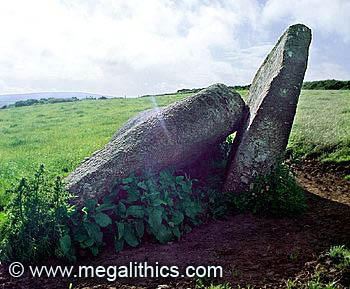
 |
|
Photo Gallery |
|
|
VR Panoramas |
|
|
|
Infrared |
|
| SW 42315 33794 (GPS 15min) | |
| Visited June 2000 |
The sad remains of the West Lanyon Quoit lie only 800m WNW of the better known Lanyon Quoit. Standing on a SW slope, only two stones of any size remain, and there are few visible clues to the original configuration of the monument. The largest stone is a substantial slab over 2m long projecting well over 1m out of the soil. We could not tell how much of this stone lay underground, but if the buried portion was of any size, this could be a candidate for the capstone.
Looking into early antiquarian accounts revealed the discovery and subsequent near destruction of the Quoit. One account (1) tells of how the owner of the Lanyon estate was sheltering from rain behind a bank when he noticed how rich the earth there was, he consequently directed his servants to remove it for use as compost. "near a hundred cart loads" were removed when "the supporters of a Cromleh" were observed. The stones enclosed a rectangular space open at the north, the east side stone was 10.5ft long, the west 9ft with a small additional stone to make10.5ft, and stone at the south about 5 ft wide. There was a large capstone 13.5ft by 10.5ft and this was "slipped off on the south side", this stone and the southern remain at the site today.
When the owner "observed it to be a Cromleh" he told his men to dig into the internal space. They came across " a broken urn with many ashes", half a skull and "most of the other bones of a human body". "The skull and some other bones were carried into the gentleman's house, and shewn to his friends as curiosities, but were afterwards re-interred in the same spot, enclosed in a box." In an area of acid soil, the finding of intact bones is unusual, particularly ones in an uncremated state. The bones do not seem to have been in articulation as they are reported to have been "in such a disordered manner as fully proved that the grave had been opened before".
The position of the capstone upon discovery is puzzling, the monument seems to
have been deeply buried, presumably in its original covering mound. It does not
seem likely that the capstone could have been displaced by such a large degree
whilst buried. This also came to the notice of Borlase
(2), who doubted that
" this stone was ever raised to the place for which it had been
intended" and felt that the builders "were never able to complete the
stupendous work which they had begun." He has also drawn a plan
of the monument as it appeared upon discovery.
Whatever the reason for the displacement of the capstone, the western and
eastern side stones were both "split up and carried away for
building" soon after discovery.
1. Archaeologia xiv, p228,
1803.
2. Borlase W.C. Naenia Cornubiae, Longmans, Green, Reader and Dyer,
London, 1872